At first there didn’t seem to be anything unusual about the man who, in 2010, reported to a Verona, Italy emergency room. He was short of breath, sweating, and had low blood pressure – cardiovascular trouble, no doubt. E.R. doctors see similar symptoms all the time.
But this man was very different indeed. He had two hearts.
“We haven’t ever seen anything similar to this case before,” Dr. Giacomo Mugnai said in an email.
It turned out that a few years earlier, the man had undergone a procedure known as a heterotopic heart transplant. Unlike an orthotopic transplant, in which one organ is removed and another put in its place, a heterotopic transplant pairs a new organ with a diseased one.
“We see this in cardiac patients or kidney patients, sometimes,” explained Dr. Rade Vukmir, professor of emergency medicine at Temple University and a spokesman for the American College of Emergency Physicians. “Surgeons might leave a kidney in place if it’s too much trouble to take out, or if there is hope for recovery of a kidney, or a heart, after a period of time” of being helped by the new organ.
In the case of the ailing Italian, reported in the Annals of Emergency Medicine, the transplant team had mated his new heart with his malfunctioning old one. Chambers and blood vessels of the two hearts were married so that the new heart could support the old one.
But there’s a risk, explained Vukmir. “You can develop two independent heart rhythms, especially in a scenario where one heart gets a little better,” he said.
That’s what happened to the 71-year-old Italian. At first doctors tried drug therapy to correct the dysrhythmia problem, but his blood pressure continued to drop and eventually his heart – actually his hearts – stopped, he lost consciousness, and stopped breathing. One jolt with a heart defibrillator brought him back. Surgeons then replaced his implanted pacemaker, and today he’s healthy, and still with two hearts.
Such patients are extremely rare these days, Vukmir explained. In the 1990s and into the 2000s, external machines called ventricular assist devices could be used to do the job the second heart in the Italian man was doing, but they were enormous, and enormously expensive. Putting in a second heart was a workable alternative. Today, though, the devices have shrunk to a manageable, portable size and heterotopic heart transplants are almost never done. Fortunately, Vukmir said, well-trained E.R. doctors are made aware that some people are still walking around with bodies that give new meaning to the term “a lotta heart.”
